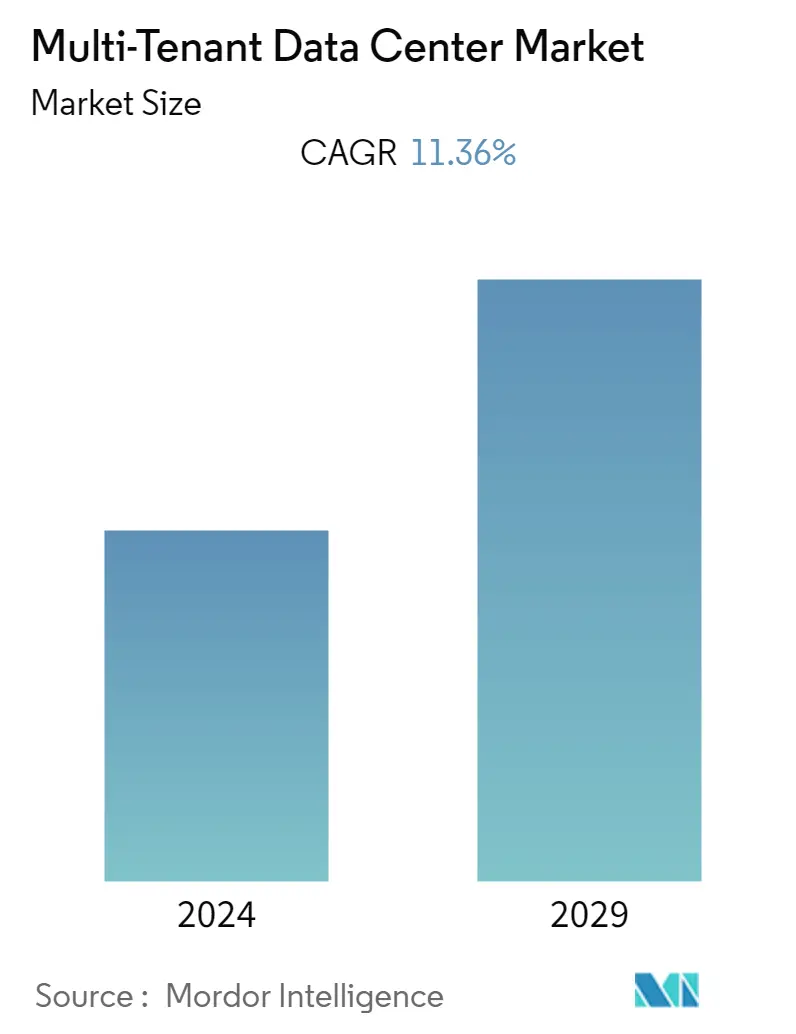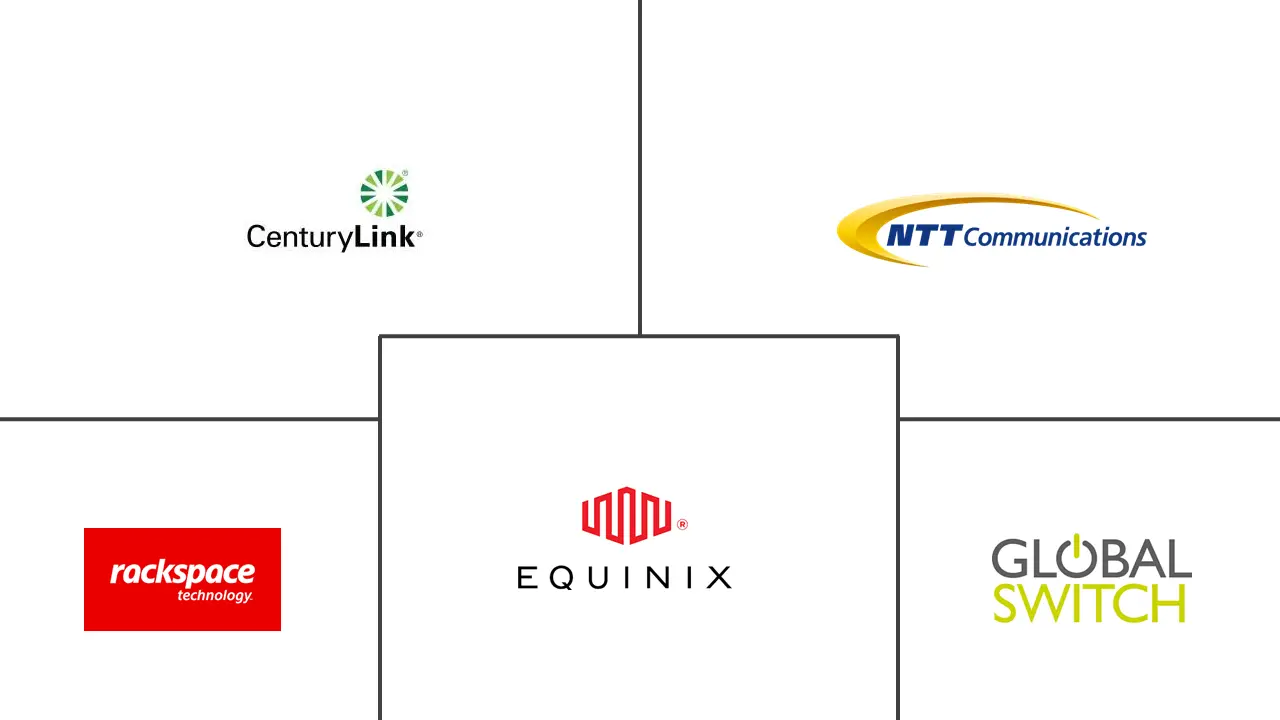Market Size of Multi-Tenant Data Center Industry

| Study Period | 2019 - 2029 |
| Base Year For Estimation | 2023 |
| CAGR | 11.36 % |
| Fastest Growing Market | Asia-Pacific |
| Largest Market | North America |
| Market Concentration | Low |
Major Players
*Disclaimer: Major Players sorted in no particular order |
Multi-Tenant Data Center Market Analysis
The multi-tenant data center market is expected to register a CAGR of 11.36% during the forecast period. Business processes are expanding rapidly, and due to this, there is a surge in demand for data centers, resulting in the evolution of multi-tenant data centers.
- Multi-tenant data centers cater to multiple clients with a single instance of a software application, with clients having a shared affinity at some level. Also, it allows enterprises to serve clients and end users better. Hence, there is a surge in the overall demand for multi-tenant data centers from cloud providers and enterprises, which is fueling the market's growth significantly.
- The primary factor driving the growth of multi-tenant data centers is the growing popularity of green data centers. The consumption of electricity and the increase in carbon emissions by data centers globally are creating awareness among enterprises about the need for green data center facilities. In the next few years, the multi-tenant data center market will be driven by the use of software-defined data centers (SDDCs) and the growth of internet traffic.
- Some other factors, such as continuous upgradation in data centers resulting in obsolescence in existing data centers, an increase in demand for IT services, and increased IT spending, are driving the growth in the multi-tenant data center market. Also, the growth of the multi-tenant data center market is due in part to low operational costs, quick response and deployment, and technical advances in IT.
- Moreover, various significant market players are well involved in building various multi-tenant data centers. For instance, in August 2022, Kansas-based Quality Technology Services (QTS) plans to develop the world's largest multi-tenant data center campus across 615 acres of current farmland just west of downtown Fayetteville to expand its metro Atlanta footprint. The Fayette County Development Authority sold the property to QTS for just USD 154 million, or roughly USD 250,000 per acre.
- Concerns about data security and the inflexibility of some multi-tenant data centers are two problems that the multi-tenant data center market has to deal with. These problems could slow the market's growth over the next few years.
- The data center sector had been changing for a long time, but the last several years have been particularly challenging, mainly owing to the COVID-19 pandemic. The surge in remote school and work, making business calls on Zoom instead of the phone, and utilizing an app for everything is a permanent trend. The fast growth of online activity has raised the demand for data center white space, particularly in recent years, as the COVID-19 pandemic made access to internet applications a requirement. With more people relying on the internet for work, social networking, e-commerce, banking, and entertainment, the demand for almost limitless uptime and storage capacity kept growing.
Multi-Tenant Data Center Industry Segmentation
Multi-tenant data centers help enterprises outsource their IT infrastructure and connect to a wide variety of ISPs securely and dynamically. Third parties operate multi-tenant data centers for the benefit of multiple enterprise tenants. They are also known as colocation data centers. Colocation is a data center facility where a corporation can rent space for servers and other computing hardware. Data center colocation is used for wholesale colocation and retail colocation.
The multi-tenant data center market is segmented by solution type (retail colocation, wholesale colocation), application (public cloud, private cloud), end-user industry (IT & Telecom, Healthcare, Defense, Manufacturing, Retail), and geography (North America, Europe, Asia-Pacific, Latin America, the Middle East, and Africa). The market sizes and forecasts are provided in terms of value (USD million) for all the above segments.
| By Solution Type | |
| Retail Colocation | |
| Wholesale Colocation |
| By Application | |
| Public Cloud | |
| Private Cloud |
| By End-user Industry | |
| IT & Telecom | |
| Healthcare | |
| Defense | |
| Manufacturing | |
| Retail | |
| Other End-user Industries |
| Geography | |
| North America | |
| Europe | |
| Asia-Pacific | |
| Latin America | |
| Middle East & Africa |
Multi-Tenant Data Center Market Size Summary
The multi-tenant data center market is poised for substantial growth, driven by the increasing demand for efficient and scalable data storage solutions. This market segment, which serves multiple clients through a single software application instance, is gaining traction due to its ability to enhance service delivery for enterprises and cloud providers. The rise in internet traffic and the adoption of software-defined data centers are key factors propelling this growth. Additionally, the shift towards green data centers, aimed at reducing carbon emissions and electricity consumption, is becoming a significant driver. The market is also benefiting from advancements in IT technology, low operational costs, and the need for rapid deployment and response. However, challenges such as data security concerns and inflexibility issues may pose obstacles to market expansion.
The retail colocation sector, a subset of the multi-tenant data center market, is expected to experience significant growth, particularly in developing regions. This growth is fueled by the high demand for colocation services, which offer cost-effective solutions for enterprises needing distributed capacity without the burden of owning a data center. Key players in the market are actively investing in new facilities and expanding their presence to meet the growing demand. The Asia-Pacific region, with its burgeoning economies like China and India, is a focal point for market expansion due to the increasing outsourcing of managed hosting services and the rise of hyper-scale platforms. Strategic investments and partnerships, such as those by Microsoft and Cyxtera, are further enhancing the market's growth prospects, positioning it for continued expansion in the coming years.
Multi-Tenant Data Center Market Size - Table of Contents
-
1. MARKET INSIGHTS
-
1.1 Market Overview
-
1.2 Industry Attractiveness - Porter's Five Forces Analysis
-
1.2.1 Bargaining Power of Suppliers
-
1.2.2 Bargaining Power of Buyers/Consumers
-
1.2.3 Threat of Substitute Products
-
1.2.4 Threat of New Entrants
-
1.2.5 Intensity of Competitive Rivalry
-
-
1.3 Industry Value Chain / Supply Chain Analysis
-
1.4 Assessment Of The Covid-19 Impact On The Industry
-
-
2. MARKET SEGMENTATION
-
2.1 By Solution Type
-
2.1.1 Retail Colocation
-
2.1.2 Wholesale Colocation
-
-
2.2 By Application
-
2.2.1 Public Cloud
-
2.2.2 Private Cloud
-
-
2.3 By End-user Industry
-
2.3.1 IT & Telecom
-
2.3.2 Healthcare
-
2.3.3 Defense
-
2.3.4 Manufacturing
-
2.3.5 Retail
-
2.3.6 Other End-user Industries
-
-
2.4 Geography
-
2.4.1 North America
-
2.4.2 Europe
-
2.4.3 Asia-Pacific
-
2.4.4 Latin America
-
2.4.5 Middle East & Africa
-
-
Multi-Tenant Data Center Market Size FAQs
What is the current Multi-Tenant Data Center Market size?
The Multi-Tenant Data Center Market is projected to register a CAGR of 11.36% during the forecast period (2024-2029)
Who are the key players in Multi-Tenant Data Center Market?
CenturyLink Inc., Equinix Inc., Global Switch Ltd., NTT Communications Corporation and Rackspace Inc. are the major companies operating in the Multi-Tenant Data Center Market.

